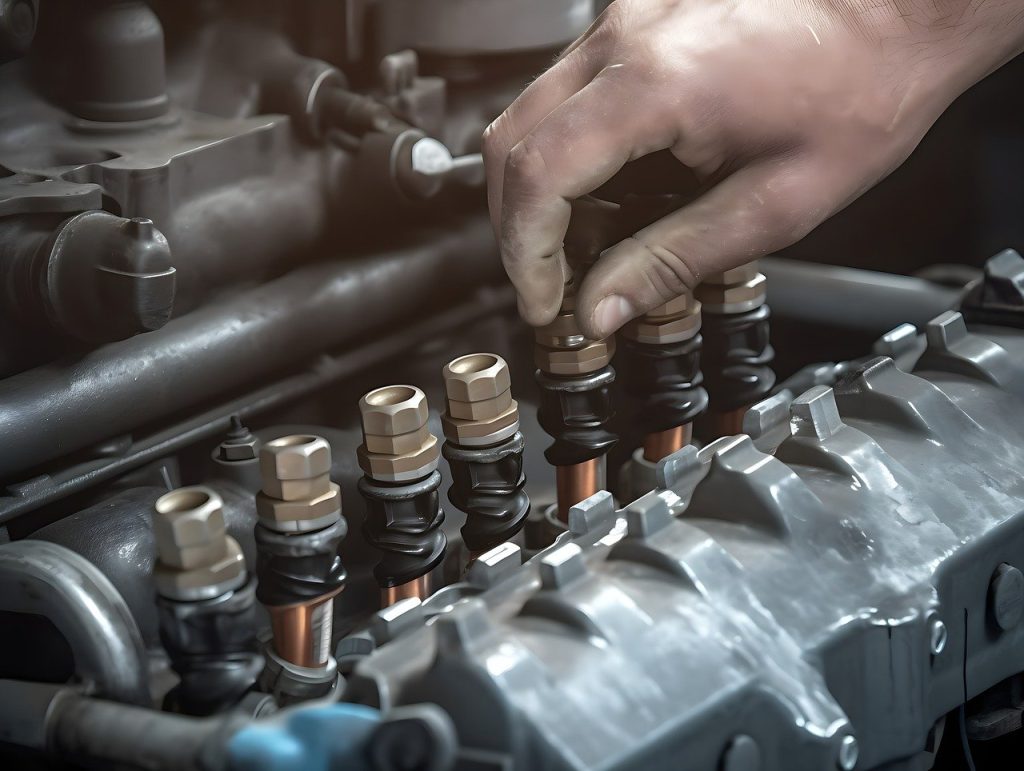The spark plug plays an important role in the combustion engine yet is often underestimated. It is the spark plug that initiates the explosion within the engine’s cylinders, turning fuel into power. However, engine stalling is a frustrating and inconvenient phenomenon that affects drivers worldwide. But can the spark plug be the culprit of this issue?
The answer to this question is that one of the culprits behind your engine’s pause could indeed be the spark plug.
The purpose of this article is to take a closer look at the relationship between spark plugs and engine stalling. We’ll explore the inner workings of spark plugs, and most importantly, look at how spark plugs can play a role in this frustrating phenomenon.
Common Causes of Engine Stalling
Let’s take a closer look into the realm of engine stalling and the myriad factors that can bring your car to an unexpected halt. Engine stalling is not just inconvenient, but potentially hazardous, especially if it occurs in traffic or on a busy road. This is why it’s important to know why it happens and how you can prevent it.
To understand the impact spark plugs can have on engine stalling, we first need to take a look at the common causes that might make your engine stall:
Fuel Delivery Problems: Any disruption in the flow of fuel to your engine can spell trouble. Clogged fuel filters, a malfunctioning fuel pump, or even a glitch in the fuel injection system can lead to inadequate fuel supply. Ultimately, this will starve your engine of the fuel it needs to keep running.
Electrical System Issues: Your vehicle’s electrical system ensures that all the components work harmoniously. Faulty ignition coils, worn-out spark plug wires, or a malfunctioning distributor can disrupt the electrical rhythm necessary for smooth engine operation.
Air Intake Issues: Engines need oxygen to burn fuel efficiently. Any hindrance in the air intake can upset the delicate balance of the air-fuel mixture, causing the engine to falter. This may include things like a dirty air filter, a malfunctioning mass airflow sensor, or vacuum leaks,
These common culprits can provide valuable context for assessing how spark plugs might fit into the engine stalling equation. While spark plugs might seem like a minor player in this ensemble of potential problems, they do have an important role to play in maintaining the balance needed for the combustion process.
Signs of a Faulty Spark Plug
Now that we have a good understanding of the common causes of engine stalling, let’s look at one of the key questions related to the spark plug issue: the telltale signs of a spark plug gone bad.
Misfiring and Rough Idling: Your vehicle’s engine runs thanks to hundreds of components working together in harmony. But when a spark plug misfires, it can have consequences on the proper functioning of the engine. If you’ve ever felt your engine shudder or noticed a persistent rough idle, it’s a strong indicator that one or more spark plugs might not be doing their job properly.
Poor Fuel Efficiency: If you’ve observed a sudden drop in fuel efficiency, it could be due to spark plugs not igniting the fuel-air mixture effectively.
Difficulty Starting the Engine: When you turn the key (or push the button) to start your vehicle, you expect it to start rapidly. If your engine hesitates or struggles to start, it could be a sign that one or more spark plugs aren’t generating the necessary spark to kickstart the combustion process.
Engine Stalling and Power Loss: The main issue we’re exploring in this article – engine stalling. If your engine tends to stall, especially during acceleration or when idling, it could very well be due to problematic spark plugs. They might not be producing the consistent sparks needed to keep the engine running smoothly.
Increased Emissions: Modern vehicles come equipped with emission control systems that reduce harmful gases. When spark plugs are in poor shape, incomplete combustion can lead to increased emissions.
How Spark Plugs Can Cause Engine Stalling
Let’s look into the question of how spark plugs can trigger the frustrating phenomenon of engine stalling.
Disrupted Combustion: To understand how spark plugs can lead to engine stalling, it’s important to understand their primary function. Spark plugs are the spark providers in the ignition system and are responsible for igniting the fuel-air mixture within the engine’s cylinders. When a spark plug is damaged, or worn out, it can fail to generate the necessary spark for combustion. This incomplete or erratic combustion can cause the engine to misfire, sputter, or even stall.
Fouled Spark Plugs: A spark plug is a tiny, precision-engineered torch. Over time, carbon deposits, oil, and other contaminants can accumulate on the plug’s electrodes, insulating them and inhibiting the spark. When this happens, the spark plug’s ability to ignite the air-fuel mixture diminishes. This can lead to erratic engine behavior, which may include stalling.
Worn Spark Plugs: Much like any other part, spark plugs wear out with time and use. As they wear, the spark they produce may become weaker or less consistent. This can result in misfires, rough idling, and engine stalling. Worn spark plugs can’t deliver the reliable ignition required for smooth engine operation.
Overheating: Spark plugs are subjected to extreme temperatures within the engine’s combustion chambers. When they overheat due to factors like a lean air-fuel mixture or excessive engine load, the electrodes can erode, causing the spark plug to fail. This can, in turn, lead to engine misfires and stalling.
Insufficient Spark Gap: The gap between a spark plug’s electrodes plays a critical role in generating the spark needed for combustion. If this gap widens due to wear or manufacturing defects, it can result in a weak or intermittent spark, causing engine misfires and, ultimately, stalling.
Preventive Maintenance and Care
Now it’s time to shift our focus towards prevention and proactive care.
Regular Inspection: It’s important to inspect your spark plugs at recommended intervals. Most manufacturers provide guidelines on when to inspect and potentially replace spark plugs.
Cleaning and Gapping: Like any piece of equipment, spark plugs can benefit from a good cleaning. If you find any fouling or deposits during the inspection, clean the spark plugs carefully. Moreover, ensure that the spark plug gap is within the manufacturer’s specifications. An incorrect gap can lead to weak sparks and performance problems.
Correct Spark Plug Type: It’s easy to assume that all spark plugs are created equal but this isn’t the case. Different engines require specific spark plug types. Make sure you’re using the right spark plugs for your vehicle’s make and model. Read your owner’s manual or a trusted mechanic if you’re unsure.
Quality Matters: When it comes to spark plugs, quality should never be compromised. Investing in high-quality spark plugs may cost a bit more initially but can pay off in the long run by providing consistent performance and durability.
Driving Habits: Believe it or not, your driving style can influence the lifespan of your spark plugs. Aggressive driving, frequent short trips, and extended idling can all put extra stress on your spark plugs. For this reason, consider adjusting your driving habits for the sake of your engine’s health.
Fuel Quality: The quality of fuel you use can impact spark plug life and performance. Using high-quality, clean fuel can help prevent carbon buildup on the spark plugs, reducing the chances of fouling.
Troubleshooting Spark Plug Issues
What happens when you suspect that your spark plugs might be causing trouble? Let’s go through the process of troubleshooting spark plug issues.
Diagnostic Tools
The first step in troubleshooting spark plug issues is to get the right tools. A spark plug socket, a gap gauge, and a spark plug tester can be helpful for a thorough diagnosis. These tools help you remove, inspect, and test your spark plugs effectively.
Visual Inspection
Start by examining the spark plugs. Look for signs of fouling, such as dark deposits or oil residue on the electrodes. Inspect the porcelain insulator for cracks or damage. A visual inspection can often reveal issues.
Spark Plug Removal
To get a closer look, you’ll need to remove the spark plugs. Follow your vehicle’s manual for guidance on this process. Once removed, pay attention to the condition of each plug. Are they worn, excessively dirty, or damaged?
Gap Check
Use a gap gauge to measure the gap between the electrodes. Ensure the gap matches the manufacturer’s specifications. If the gap is too wide or too narrow, it can affect spark quality and engine performance.
Spark Plug Testing
A spark plug tester can help you determine if the plug is producing a spark. Simply attach the tester to the plug wire, start the engine, and observe the spark. A strong, consistent spark indicates a healthy spark plug, while a weak or intermittent spark may signal a problem.
Compression Test
If you suspect a deeper issue like a damaged valve or piston, consider a compression test. This test can identify problems that might affect multiple cylinders and can help rule out more serious engine issues.
Replacement
If you find that one or more spark plugs are worn or damaged, it’s best to replace them promptly. Always use the recommended spark plugs for your vehicle to ensure compatibility and optimal performance.
Professional Help
If you’re unsure about any aspect of spark plug diagnosis or replacement, it’s best to seek professional assistance.

